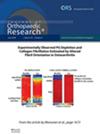Enhancing the Reliability of Cartilage Repair Evaluation: A Simplified Volume-Based Approach
Abstract
ABSTRACT
The purpose of this study was to explore methods for enhancing the reliability of arthroscopic cartilage repair evaluation. We compared a new volume-based scoring technique that assessed the extent of high-quality cartilage repair tissue in four quadrants of the repair tissue with the International Cartilage Repair Society (ICRS) score. Using a porcine cartilage repair model, we evaluated the inter- and intrarater reliability of the new volume-based technique. Nine defects were treated with a recombinant human Type III collagen/polylactide scaffold, whereas nine were left to heal spontaneously. The reliability of the volume-based score was analyzed using intraclass correlation coefficients (ICCs), and external validation was performed by comparing the score with histological ICRS II results. The volume-based score demonstrated moderate to good interrater reliability (ICC 0.67–0.78) and intrarater reliability (ICC 0.58–0.84), outperforming the ICRS score in consistency. Moderate positive correlations were observed between the volume-based score and histological ICRS II subscores (rs = 0.62–0.64, p < 0.001). These findings suggest that the volume-based approach may improve the reliability of arthroscopic cartilage repair assessment without significantly compromising the alignment with histological evaluations. Although the simplified system offers advantages in reproducibility, further refinement is necessary to balance reliability with the need for comprehensive tissue evaluation.
Level of Evidence
Diagnostics, Level III (based on comparative studies in an animal model with blinding between observers).
Statement of Clinical Significance
This study provides insights into improving the reliability of arthroscopic cartilage repair evaluations, potentially leading to more consistent and accurate assessments in both clinical and research settings.


 求助内容:
求助内容: 应助结果提醒方式:
应助结果提醒方式:


